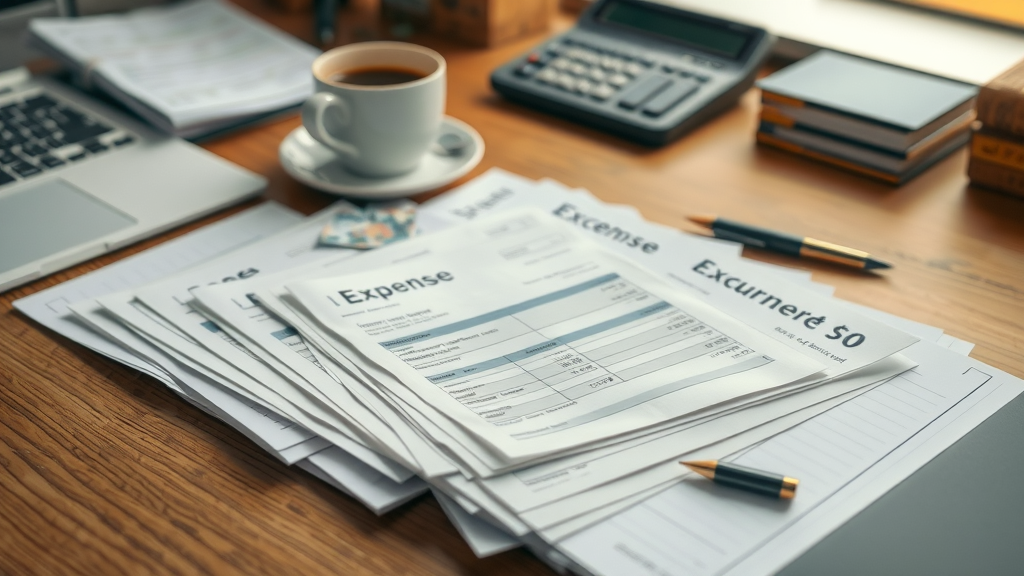Did you know nearly 60% of businesses overpay taxes every year simply because they miss out on eligible deductions? Strategic tax planning is more than good practice—it’s money left in your pocket. This guide is designed to help you unlock business owner tax savings , minimize your tax bill, and empower your small business’ financial future. Dive in to discover practical strategies, everyday tax tips, and actionable checklists that make tax-saving simple for any small business owner.
Unlocking Business Owner Tax Savings: Why Smart Tax Planning Matters
The foundation of business owner tax savings is smart, proactive tax planning. Every small business owner is entitled to a range of deductions, credits, and strategic choices that can meaningfully reduce their tax bill. But, without a plan, even the most successful entrepreneurs may miss out on these opportunities. According to the U.S. Small Business Administration, nearly 60% of businesses overpay taxes every year due to missed deductions. Taking the time to understand business tax strategies can transform your approach—directly impacting your bottom line and giving you an edge in business growth.
Practical examples of tax savings abound—from deducting home office space and office equipment to leveraging retirement plans for pre-tax savings. The key is to know which deductions are available, document expenses clearly, and review your strategy as tax laws evolve. Strong tax planning isn’t just about avoiding overpayment—it’s about putting every available dollar back into your business. That’s why maximizing business tax deductions isn’t merely compliance; it’s a vital financial tactic that can separate thriving small businesses from those barely breaking even.

"According to the U.S. Small Business Administration, nearly 60% of businesses overpay taxes every year due to missed deductions. Seize every opportunity to save with strategic planning."
Essential Concepts for Maximizing Business Owner Tax Savings
To truly tap into business owner tax savings , you first need to master core financial concepts. Understanding what the IRS considers a “business expense” is the gateway to making nearly every expenditure work for you. Accurate and organized recordkeeping is the engine powering successful claims for these deductions—every savvy owner knows it’s not just about what you spend, but how meticulously you can prove it. Both common and overlooked tax deductions—from health insurance premiums to startup costs—can be unlocked with diligent tracking and an eye for tax-saving details.
Tax-saving strategies don’t stop with expenses. Unique opportunities abound for business owners, including a variety of business tax credits, pre-tax retirement plan contributions, and methods for structuring your company to maximize the advantages. Recognizing these tax-saving opportunities, and applying them consistently, will reduce your tax bill and keep your business strong throughout every tax year.
- Understand what qualifies as a business expense
- Recognize the importance of accurate recordkeeping
- Spot both common and overlooked tax deductions
- Identify credits, deductions, and tax-saving opportunities unique to business owners

What You Will Gain: Mastering Business Owner Tax Savings
- How to effectively reduce your tax bill as a business owner
- Key tax deduction opportunities for small businesses
- Practical strategies for claiming home office deductions
- Actionable tax tips to enhance tax savings year after year
How to Save on Taxes as a Business Owner: Foundational Business Owner Tax Savings Explained
Saving on taxes as a business owner starts with understanding the building blocks of smart tax management. Proper categorization and diligent tracking of business expenses transforms ordinary purchases—like office supplies, travel, or health insurance—into legitimate tax deductions, dramatically decreasing your taxable income. Foundational steps such as reviewing expenses monthly, using digital recordkeeping, and understanding deductible items are the secrets that set apart successful entrepreneurs.
For example, consider the impact of claiming business meals and travel, leveraging health insurance costs, and setting up a legitimate home office. These deductions, when captured consistently, add up to robust tax savings over the course of a year. Plus, structuring your business—whether LLC, S-Corp, or sole proprietor—affects your business tax rate and available deductions. Each foundational move you make today sets the stage for stronger business owner tax savings tomorrow.

Small Business Tax Strategies that Deliver Maximum Business Owner Tax Savings
Strategic tax moves can dramatically increase savings for small business owners. Maximize every deduction by leveraging Section 179 for immediate asset expensing, exploring bonus depreciation on qualifying purchases, and contributing to tax-advantaged retirement accounts. Many small businesses see a significant reduction in their tax bill simply by re-evaluating which expenses they claim and when. For instance, investing in business equipment or software before year-end can accelerate your deductions and reduce your taxable income right away.
Additionally, always scrutinize your business structure. S-Corps or LLCs taxed as S-Corps can yield dividends with lower self-employment taxes. Consult a tax professional to discover the optimal structure for your business model—this single strategy can lead to ongoing tax savings and increased take-home profits every year.
Business Expense Categories: The Key to Business Owner Tax Savings
Breaking down your business expenses into proper categories is essential for both compliance and maximizing your business owner tax savings . Each expense category carries unique rules—which means correct classification can be the difference between a red flag and a rock-solid deduction. Focus on recurring expenses first, such as office supplies, travel, utilities, insurance, and marketing costs. Don’t overlook items like employee benefits, continuing education, and technology purchases—all offer value when properly tracked.
Moreover, categorized expenses simplify your tax-prep process and make it easier to identify overlooked write-offs. A habit of organizing receipts and digital statements by category gives you (and your accountant) the information needed for a stress-free tax return and optimal business tax savings.
| Expense Type | Deductible? | Example | Tax Impact |
|---|---|---|---|
| Office Supplies | Yes | Paper, Computers | Immediate |
| Travel & Meals | Yes (Partial) | Work travel, Meals | Up to 50-100% |
| Health Insurance | Yes | Owner/Employee Plans | Full/Partial |
| Home Office | Yes | Home Workspace | Portion Only |

Top Tax Deductions Every Business Owner Should Know
Every savvy business owner should become familiar with the most impactful tax deductions. The right mix of tax deductions can substantially lower your taxable income and shrink your tax liability. Some deductions, like the home office deduction or vehicle expenses, are uniquely advantageous to small business owners, offering flexibility and significant savings when properly documented. Learning which tax deductions are available—and how to prove eligibility—should be a cornerstone of your yearly financial review.
Additionally, contributions to retirement plans, insurance premiums, and depreciation of assets play a significant role in your overall tax-saving strategy. Marketing costs, employee training expenses, and professional service fees also merit special attention for their potential to lower your business tax bill. Regularly review updated IRS tax codes or consult with a tax pro to ensure you’re capturing every eligible deduction year over year.
Business Tax Deductions for Everyday Expenses
While some tax-saving techniques are complex, many of the most effective deductions are hiding in plain sight—embedded in your day-to-day business operations. The home office deduction is a classic example: If you use part of your home exclusively and regularly for business, a portion of your rent, mortgage interest, or utilities is deductible. Vehicle expenses are another goldmine—track eligible miles driven, or claim the standard mileage rate to maximize these deductions each tax year.
Asset depreciation, retirement plan contributions, insurance premiums, and regular marketing and advertising spending are all deductible expenses that reduce your taxable income. Documenting each consistently with receipts and digital logs ensures compliance and maximum benefit. These everyday deductions, when combined, deliver powerful business tax savings to both new and established business owners.
- Home office deduction
- Vehicle expenses
- Depreciation of assets
- Retirement plan contributions
- Insurance premiums
- Marketing and advertising

Home Office Deduction: How Business Owners Qualify and Benefit
The home office deduction is one of the most lucrative and misunderstood tax savings tools for business owners. To qualify, you must use a specific area of your home exclusively and regularly for business. This could be a room, or just a clearly defined section, but it can’t be shared with personal activities. If you meet the requirements, you can deduct a portion of rent, mortgage interest, utilities, insurance, and even repairs based on the square footage dedicated to your business compared to your home’s total size.
The benefit? Deductions directly reduce your taxable income, lowering what you owe on your next tax return. With proper recordkeeping—blueprints, utility bills, receipts, and photographs of your home workspace—you can confidently claim this deduction and realize significant tax savings over the lifespan of your business.
Maximizing Health Insurance Deductibility for Small Business Owners
Did you know health insurance premiums paid as a business owner are often fully deductible? For small businesses offering coverage to employees, a variety of health plan costs can reduce your taxable business income. This includes premiums for medical, dental, and qualified long-term care insurance for yourself, your family, and your workers. Plus, consider health reimbursement arrangements (HRAs) or health savings accounts (HSAs) for further pre-tax savings via employer contributions.
Always keep meticulous documentation of premium payments and policy details. Consult your tax pro annually to maximize these deductions and ensure you’re utilizing every available health-related tax-saving benefit—especially as health insurance costs continue to rise for small business owners.
Claiming Business Travel and Meal Deduction: What Is Permissible?
Business travel and meals are regularly scrutinized, yet they remain powerful tools for business owner tax savings when properly documented. Only necessary and ordinary expenses related to travel for business purposes can be deducted—think airfare, lodging, half the cost of meals, taxi rides, and even baggage fees. Meals must be directly related to business discussions or conducted during business travel to qualify for a deduction.
Keep itemized receipts and detailed logs of trip dates, purposes, and locations. The IRS allows you to deduct necessary and ordinary expenses directly related to your business. Document every eligible expense for the strongest business owner tax savings year-round. To make the most of these deductions, embrace a habit of immediate documentation and consider using business credit cards just for travel and meal expenses.
"The IRS allows you to deduct necessary and ordinary expenses directly related to your business. Document every eligible expense for the strongest business owner tax savings year-round."
Smart Planning for Business Owner Tax Savings: Retirement Plans, Credits, and Beyond
Long-term business owner tax savings isn’t possible without smart planning beyond basic deductions. Retirement plans like SEP-IRAs, Solo 401(k)s, or SIMPLE IRAs enable you to shelter more income from taxes, boosting your retirement nest egg while reducing your current-year tax bill. Setting up these plans is straightforward—and the resulting tax deduction can be substantial, especially for high-earning small business owners.
Tax credits deliver even more value, directly reducing your tax bill dollar-for-dollar. From health insurance credits for employers with fewer than 25 employees to research and development credits for innovation, these often-overlooked opportunities are worth exploring annually. And end-of-year tax-saving maneuvers (like accelerating expenses or timing income) can make a noticeable impact right before your tax return is due. Smart planning throughout the year, with regular consultations from a qualified tax pro, keeps you ahead of IRS regulations and maximizes your small business tax savings from every angle.

Establishing a Retirement Plan for Maximum Business Tax Savings
As a business owner, contributing to a retirement plan is a win-win: it builds your future security and slashes current-year tax liability. Qualified plans such as SEP IRA, SIMPLE IRA, and Solo 401(k) allow much higher contributions than standard IRAs—meaning you can defer substantial business income and reduce your immediate tax bill. For example, a Solo 401(k) lets you contribute as both employer and employee, potentially deferring over $60,000 per year tax-free (subject to IRS limits).
Not only does this yield powerful business owner tax savings, but offering retirement benefits can attract and retain top talent—further strengthening your business. Always consult a tax professional to select and maintain the right plan for your company and update contribution strategies each tax year for maximum benefit.
Key Business Tax Credits Small Businesses Shouldn’t Overlook
Unlike deductions, which reduce your taxable income, tax credits reduce your tax bill dollar-for-dollar—making them among the most valuable tax-saving tools at your disposal. Several federal tax credits exist specifically for small businesses, including the Small Employer Health Insurance Credit (covering up to 50% of premiums), the Work Opportunity Tax Credit for hiring certain qualified individuals, and the Research & Development Credit for investing in innovation.
Eligibility for these credits often depends on factors like business size, compensation, and the types of employees you hire. Make a habit of reviewing tax credits annually with your tax professional, as credits frequently change and new opportunities arise in each tax year.
| Credit Name | Eligible Businesses | Maximum Benefit |
|---|---|---|
| Small Employer Health Ins. | <25 employees, pays 50%+ premiums | Up to 50% costs |
| Work Opportunity Credit | Hires qualified employees | Up to $9,600 |
| Research & Development | Invests in innovation/R&D | Variable |
Reducing Your Business Tax Bill with Strategic Year-End Maneuvers
Year-end is your last opportunity to lock in smart moves for business owner tax savings . Strategic actions—like prepaying expenses, purchasing equipment that qualifies for Section 179 or bonus depreciation, accelerating deductions, or deferring income—can spike your tax deductions and shrink your final business tax bill. Review your income and expenses with your tax professional in Q4 for maximum flexibility.
Don’t forget to revisit your employee bonuses, charitable contributions, and retirement plan funding before December 31. Acting early helps you identify any changes in IRS rules or tax credits that could affect your final tax liability, positioning your business for optimal savings when you file your return.

Tax Tips for Small Business Owners: Boost Your Business Owner Tax Savings
Consistent, thoughtful tax management is the hallmark of successful business owners. Following these expert tips will help you boost your business owner tax savings all year:
- Review quarterly estimated payments
- Automate expense tracking and documentation
- Evaluate hire vs. contract labor for tax savings
- Consider business entity structure impact
- Leverage Section 179 for immediate asset deductions
Quarterly estimated payments help you avoid year-end tax bill surprises and potential penalties. Automating your expense tracking means fewer missed deductions and a quicker tax-prep process. Deciding between hiring or using contract labor—with guidance from a tax pro—can also impact payroll taxes and connected deductions. These tax tips, paired with an annual review of your entity structure and Section 179 opportunities, will keep your business owner tax savings strong year in and year out.

Hiring a Tax Pro: When to Rely on Professional Tax Advice
Even the most diligent business owners benefit from the expertise of a tax pro . Tax professionals keep you aligned with ever-changing laws, identify underutilized deductions, and ensure your tax return is accurate and timely. Consult a tax professional when your business grows, you add employees, change your entity structure, or approach major year-end tax maneuvers. An annual review with a tax pro saves money and eliminates costly errors that could trigger an audit or missed tax-saving chances.
Ultimately, the investment in expert tax advice pays for itself through increased compliance, fewer surprises, and maximized business owner tax savings —so you can focus on what matters most: growing your business.
People Also Ask: Business Owner Tax Savings
How do business owners save on taxes?
Business owners save on taxes by leveraging allowable deductions, tax credits, maximizing pre-tax retirement contributions, selecting optimal business structures, documenting all business expenses, and consulting with tax professionals to uncover additional strategies each tax year.

Do business owners get taxed less?
Business owners may pay lower effective tax rates than employees if they fully utilize business owner tax savings opportunities, such as deductions, credits, and income-splitting strategies. Actual tax outcomes depend on entity type, income level, and compliance with tax law.
What can you write off on taxes if you own your own business?
If you own your business, you can write off business expenses such as office supplies, equipment, marketing costs, travel, meals, home office use, insurance, retirement plan contributions, and more--all contributing to business owner tax savings.
How much to save for taxes as a business owner?
A prudent rule is to set aside 25%-30% of net business income for taxes, factoring in federal, state, and local rates. This ensures you have the cash to pay your tax bill and avoid penalties while optimizing business owner tax savings.
Step-by-Step Guide: Implementing Business Owner Tax Savings Strategies
- Review and categorize all business expenses monthly
- Automate expense tracking with accounting software
- Research eligible deductions and credits each tax year
- Project your annual tax bill with a qualified tax pro
- Schedule annual and quarterly tax planning reviews
- Invest in tax-advantaged retirement plans
- File accurate and timely returns to secure all business owner tax savings

Avoiding Common Tax Mistakes that Affect Business Owner Tax Savings
Some mistakes can erode even the best business owner tax savings plans. Mixing personal and business expenses is a common pitfall—keep accounts and credit cards separate at all times. Neglecting to document and store proof of deductions often leads to disallowed expenses and lost savings. Missing eligible tax credits and failing to maintain records for home office deductions can cost you dearly at tax time. Avoid these errors by maintaining organized documentation and conducting regular financial reviews—your tax bill will thank you.
- Mixing personal and business expenses
- Neglecting documentation for deductions
- Missing eligible tax credits
- Ignoring recordkeeping for home office deductions
Case Studies: Real Business Owner Tax Savings in Action
Case Study: Small Business Owner Gains with Home Office Deduction
Meet Jennifer, an independent consultant who runs her business from a dedicated home office. By calculating the square footage of her 200-square-foot office compared to her 2,000-square-foot home, she deducted 10% of her rent, utilities, and insurance as a home office expense. Over the course of a year, this strategy saved her more than $3,000 on her business tax return—realizing business owner tax savings that funded a key business expansion.

Case Study: How Strategic Retirement Contributions Reduced a Tax Bill by 30%
Tom, a small business owner, started making regular contributions to a SEP IRA after consulting with a tax pro. By maximizing these contributions, he was able to defer significant business income, reducing his taxable income by $20,000. The result was a 30% decrease in his annual tax bill. This allowed him to invest more back into his growing company while also building long-term retirement security. Tom’s success shows how the right retirement plan and expert guidance can unlock powerful business owner tax savings every year.
Expert Quotes on Business Owner Tax Savings
"For small businesses, proactive planning is the difference between marginal and maximized tax savings from year to year." — Certified Tax Professional
"Deductions and credits can cut a business tax bill dramatically. Stay current on tax laws to keep more profits working for your business." — Small Business Tax Advisor
Business Owner Tax Savings FAQs
-
What are the most overlooked business tax deductions for small businesses?
Start-up costs, employee training, business insurance, software subscriptions, and home office costs are often missed. Careful tracking and consulting with a tax pro ensure these tax savings are realized. -
How can a business owner plan for quarterly taxes effectively?
Review your business income, estimate liabilities, and set aside tax savings monthly. Use accounting software and consult a professional quarterly to adjust payments and reduce surprises. -
Are home office deductions frequently audited?
The IRS does review these, but businesses with sound documentation and compliance rarely face issues. Clear records and exclusive use of the office space are key for audit-proof claims. -
What’s the benefit of consulting a tax pro annually?
A tax professional ensures you’re maximizing deductions, using the latest credits, and avoiding costly tax mistakes that could raise your tax bill or increase audit risk. -
How do tax savings change for LLCs vs. S-Corps or sole proprietorships?
LLCs, S-Corps, and sole proprietors have access to different deductions, income-splitting options, and tax rates. Reviewing your structure yearly helps capture the biggest business owner tax savings available to your situation.
Key Takeaways for Maximizing Business Owner Tax Savings This Year
- Proper documentation unlocks more deductions
- Home office, retirement plans, and credits boost savings
- Review strategies each tax year for newest savings
- Partner with tax professionals for maximum impact
See It in Action: Business Owner Tax Savings Video Guide
Watch: How Small Businesses Optimize Tax Deductions
Visual learning helps make tax strategies clear. Search online for reputable video guides from tax professionals demonstrating real-life business owner tax savings and deduction examples.
Visual How-to: Navigating Common Deductions and Credits Video
Look for step-by-step video walk-throughs on navigating deductions and credits—guides updated yearly by certified tax pros are especially valuable for small businesses keeping current.
Start Maximizing Your Business Owner Tax Savings Today
- Review this checklist monthly
- Schedule a tax planning session this week
- Discover overlooked deductions with a professional
- Build a plan to minimize your business tax bill year-round
To further enhance your understanding of tax-saving strategies for business owners, consider exploring the following resources:
-
“12 Money-Saving Tax Strategies for Small Business” : This article provides practical tips on tracking receipts, paying for health insurance, and utilizing the qualified business income deduction to maximize tax savings. ( uschamber.com )
-
“7 Tax Strategies to Save Money for Small Businesses” : This resource outlines strategies such as setting up retirement plans and writing off equipment and real estate purchases to reduce taxable income. ( ondeck.com )
These articles offer actionable insights to help you implement effective tax-saving measures in your business operations.
 Add Row
Add Row  Add
Add 




Write A Comment